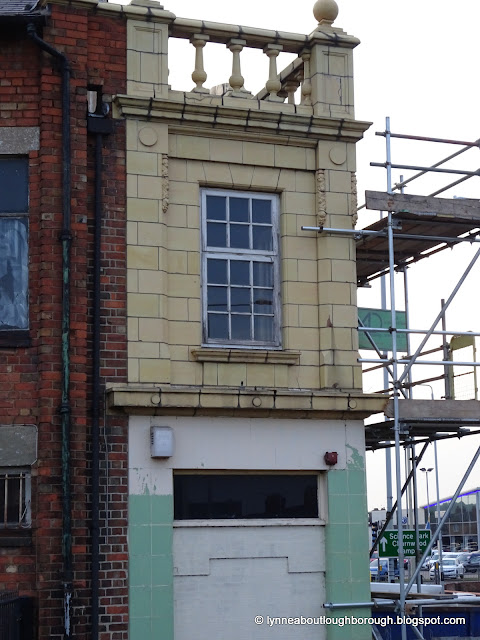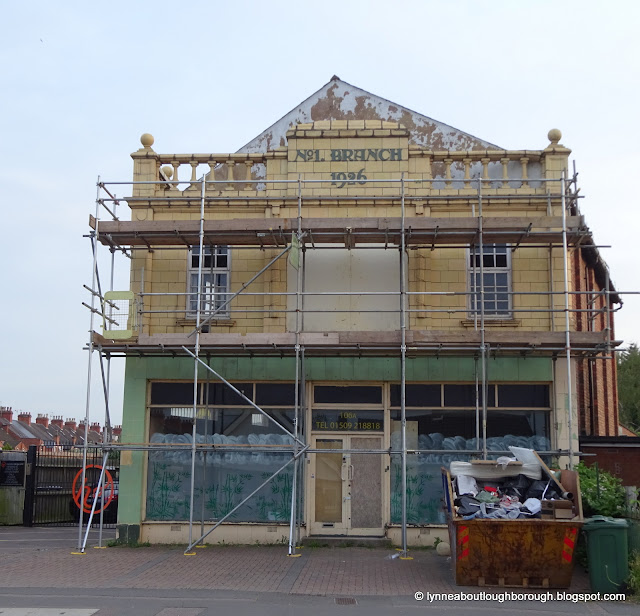The former Co-operative stores building on Derby Road has had many uses over the years, since opening as a Co-op store in 1926, and there is currently a planning application in to convert the upper floors to flats.
 |
| Former Co-operative store on derby Road undergoing renovation |
The Co-operative Society was begun by pioneers in Rochdale – the Rochdale Society of Equitable Pioneers – a group formed in 1844 of 28 people, half of whom were weavers, who found themselves descending into poverty because of the mechanisation of work they’d previously done manually and skillfully. And so, the 28 tradesmen worked together to open a food store, each contributing £1, which enabled them to purchase foodstuffs that individually they would not have been able to afford. As we now know, this led to the successful Co-operative Society movement across the country.
Leicester’s Co-op society began in 1860, and like the Rochdale group consisted mostly of weavers, web weavers to be precise, although there were only 7 of them. Messrs Woodford, Wilford, Norton, Herbert, Sharpe, Silverwood and Burrows each contributed 3d. to the share account and so formed the society. After a difficult few years, by 1871 the society was thriving and had a membership of over 3,000 and 12 stores.
By comparison, the Loughborough Co-operative movement was certainly active as early as 1866, for in November of that year there is a newspaper report covering a great reform demonstration that was held in the town, which mentions the group:
“Following the example of other large towns…a great demonstration took place at Loughborough for the furtherance of the cause of Reform.”
“At two o’clock a procession began to be formed in the Market
Place, in front of the Corn Exchange [Town Hall], in the following order: The
Nottingham Temperance Sax-Tuba Band, the deputations from Leicester and Manchester,
the General Committee in a wagonette, with postillion, the Leicester Albion
Band, the Loughborough Trades’ Unions, and Friendly Societies, the Loughborough
Co-operative Society and Band …”
Further reference to a Loughborough store appears in a newspaper of December 1867, when the store on Wood Gate was advertising for a grocer’s assistant: they wanted someone who was at least partway through their seven-year apprenticeship.
 |
| The former Co-op store on Wood Gate |
I haven’t investigated the history of the Wood Gate store, apart from the fire of 1884, so let’s move onto the Derby Road store. We know from the façade of the building that it was built in 1926, and we know from the look of the façade that it is clad in faience tiles. If these tiles were provided by the Hathern Station Brick and Terra Cotta Company, they would be known as Hathernware. The Co-operative building is situated adjacent to the Burleigh Brook, which is itself on the Derby side of what was then the Charnwood Forest Railway, which terminated/began at the Derby Road between the brook and what was the Station Hotel, now a funeral parlour.

Former Co-op store on Derby Road 
Former Co-op store on Derby Road showing detail

Former Charnwood Forest Railway building
In January 1932, the building was the subject of an attempted burglary, by a person armed with a screwdriver, a flash-lamp, a file and a gimlet. Clearly, the building was at one time surrounded by a fence, as the man was apprehended by a police constable who had unlocked the front gate and found the burglar, sitting on the steps of the store.
In February 1939, due to the diligence of a local fire-fighter, who noticed smoke coming from the garage associated with the Co-op, serious damage to the buildings was averted, as he single-handedly tackled the blaze. The garage at the back housed the mobile shop which used to travel around various parts of Loughborough at one time.
The building had space upstairs that was big enough to be used for parties, wedding receptions, dance lessons and dances.
In 1960 the Loughborough Co-operative Society merged into the Leicester Co-operative Society, the latter being joined with Oadby in 1957, and Glenfield, Kirby Muxloe, Ratby, Quorn, Croft and Groby having joined in 1959. Burbage also joined the Leicester society in 1960, while Mountsorrel joined in 1963. Further mergers continued until in 1969 the Leicester Co-op Society itself merged and became part of the Leicestershire C-operative Society.
South Leicestershire Co-operative Society was the last to join the Leicestershire Co-op in 1984, before In 1985, the Leicestershire Co-operative Society merged with the Central Midlands Co-operative Society to become the Midlands Co-operative Society. In 2001 the latter was joined by the Chesterfield and District Society, followed in 2006 by Desborough and Ilkeston, and by 2010, the Midlands Co-operative Society was the biggest independent retail society in the UK.
The Derby Road Co-op seems to have continued to be a Co-op store into the 1970s, but certainly by about 1978 it had become a sort of bric-a-brac shop selling railway-related items, upstairs was a working model train. Later, the shop became a pine furniture shop and finally ended up being a Chinese restaurant. In 2017 it was reported that it was to become a venue and meeting place for the Redeemed Christian Church of God, but that seems never to have happened, and the place has remained empty since then … until now, as it is being renovated and converted to flats.
The question still remains, however, as to what the No.1 on the building’s façade, relates to. Several theories have emerged:
*Was it the first Co-op in Knightthorpe? It could not have been the firstCo-op store in Loughborough, as the store on Wood Gate opened in the 1860s
*Had the Loughborough Co-operative Society merged with another local society, and this was the first building to be built and occupied by the merged Society?
*Was it a road number? Perhaps intended to be the start of
Alan Moss Road?
*Was it the first of Loughborough's buildings to be clad in
Hathernware faience tiles?
*Was it the first to be built along the Charnwood Forest
railway line, with others planned along the route?
*Was it the first self-service Co-op in the area?
Anyway, over the years there have been, and indeed still are, various Co-op stores across town including, on Loughborough High Street and Swan Street, on Lansdowne Drive, on the site of the Maltings pub off Epinal Way, on Nottingham Road, on Derwent Drive and on Ashby Road.
Posted by lynneaboutloughborough 27 June 2021
You are welcome to quote passages from any of my posts, with appropriate credit. The correct citation for this looks as follow:
Lynne


























